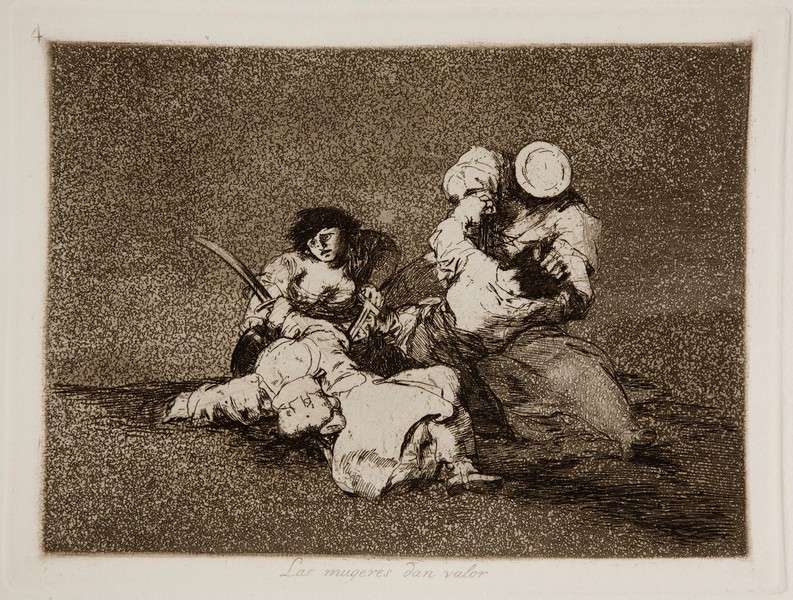- Cronología
- Ca. 1810 - 1815
- Dimensiones
- 155 x 206 mm
- Técnica y soporte
- Etching, lavis, drypoint, burin and burnisher
- Reconocimiento de la autoría de Goya
- Undisputed work
- Ficha: realización/revisión
- 25 Nov 2010 / 24 May 2023
- Inventario
- 225
28 (lower left-hand corner).
See Sad presentiments of what must come to pass.
There exists a state proof in which lavis and aquatint were added right up to the edges, and drypoint was used to retouch the woman's left cheek. No state proof with just the engraved number 34 has been conserved, but another state proof, featuring both that number and the number 4, has survived.
The title was handwritten by Goya on the first and only print run that we know to have been made at the time, and which the painter gave to his friend Agustín Ceán Bermúdez. The title was engraved on to the copperplate at a later date, and no other modifications were made to the image for the first edition of the Disasters of War, which was printed by the Royal Academy of Fine Arts of San Fernando, Madrid, in 1863.
No preparatory drawings for this print have been conserved.
In the centre of the scene a French soldier grapples with a woman, pulling her violently by the hair. Next to this pair, another female figure fights with a second French soldier lying on the ground, whom she has just stabbed with a sword. The bold dynamism of this image is achieved through the use of diagonal lines in the composition, giving a sensation of instability to the figures. This same device has been used in many other prints in the Disasters of War series.
Aquatint has been applied over the whole of the background, as well as on the ground. The result is a grainy effect that, on the one hand, cancels out any spatial references whilst at the same time creating an oppressively dark atmosphere that heightens the sinister character of the scene.
There are several images in which Goya speaks of the decisive role played by women in war. Victims of rape and assault, they find themselves in circumstances in which they are forced to defend themselves in any way possible. This print is related to no. 5, And are like wild beasts, which appears to conclude the narration being told here in print no. 4, or to add emphasis to it.
Other prints in the series in which Goya deals with women's involvement in war include no. 7,What courage!, no. 9, They do not want to, no. 11, Or these, no. 13, Bitter presence, no. 19, There is no more time and no. 31 That's tough!.
The etching plate is conserved in the National Chalcography Museum (cat. 255).
-
GoyaMinistry of Foreing AffairsBurdeos1951organized by the Bordeaux City Hall, consultant editor Gilberte Martin-Méry. From May 16th to June 30th 1951p. 72, cat. 2
-
Goya. Das Zeitalter der Revolucionen. Kunst um 1800 (1980 – 1981)Hamburger KunsthalleHamburg1980cat. 70
-
Francisco de GoyaMuseo d'Arte ModernaLugano1996exhibition celebrated from September 22nd to November 17th.cat. 4
-
Francisco Goya. Sein leben im spiegel der graphik. Fuendetodos 1746-1828 Bordeaux. 1746-1996Galerie KornfeldBern1996from November 21st 1996 to January 1997cat. 93
-
Francisco Goya. Capricci, follie e disastri della guerraSan Donato Milanese2000Opere grafiche della Fondazione Antonio Mazzottacat. 83
-
Goya. Opera graficaPinacoteca del Castello di San GiorgioLegnano2006exhibition celebrated from December 16th 2006 to April 1st 2007p. 53
-
Goya et la modernitéPinacothèque de ParisParís2013from October 11st 2013 to March 16th 2014cat.43
-
2022
-
Goya, grabadorMadridBlass S.A.1918cat. 106
-
Goya engravings and lithographs, vol. I y II.OxfordBruno Cassirer1964cat. 124
-
Vie et ouvre de Francisco de GoyaParísOffice du livre1970cat. 997
-
Catálogo de las estampas de Goya en la Biblioteca NacionalMadridMinisterio de Educación y Cultura, Biblioteca Nacional1996cat. 186
-
ParísPinacoteca de París2013p. 121
-
Goya. In the Norton Simon MuseumPasadenaNorton Simon Museum2016pp. 114-151
-
Museo de Bellas Artes de Badajoz y Diputación de Badajoz2022p. 53
